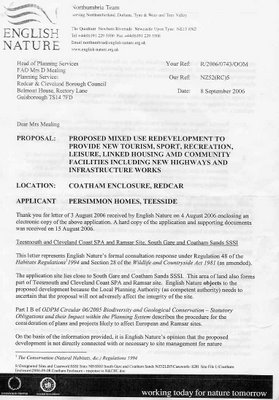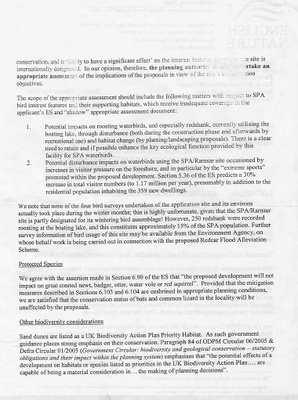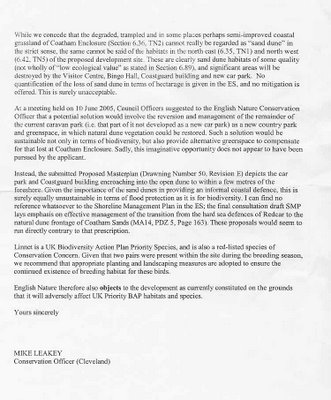Monday, September 25, 2006
Objections from three statutory bodies
ANNEX
RSPB response to planning application Ref: R/2006/0743/OOM
Proposed mixed use redevelopment to provide new tourism, sport, recreation, leisure, linked housing and community facilities including new highways and infrastructure works at Coatham Enclosure,
DETAILED COMMENTS BY THE RSPB
![]()
Importance of the Site
Nature conservation value of the area:
• The application site lies adjacent to
• The SPA was designated in 1995 and extended in 1999. The SPA qualifies as a site of European ornithological importance because it is used regularly by at least 1% of the GB population of two Annex I species: little tern and sandwich tern. This means it qualifies for SPA designation under Article 4.1 of the European Union’s Directive on the Conservation of Wild Birds (79/409/EEC as amended)(’the Directive’).
• The site also qualifies for designation under Article 4.2 of the Directive because it is used by 1% or more of the bio-geographic population of two regularly occurring migratory species knot and redshank - and it regularly supports an assemblage of over 20,000 water birds.
• A review of the
• In 1995 the Teesmouth and Cleveland Coast was also designated as a Ramsar Site under the Ramsar Convention on Wetlands of International Importance Especially as Waterfowl Habitat (1971) (‘the Ramsar Convention’). The site was extended in 2000 so that it is congruent with the SPA: It qualifies under several elements of the Ramsar
Convention:
• Criterion 2c as an important staging area for waterfowl
• Criterion 3a by regularly supporting over 20,000 waterfowl in winter
• Criterion 3c by regularly supporting internationally important numbers of knot
• Criterion 2a due to its rich assemblage of Red Data Book invertebrates
• It is UK Government policy that Ramsar Sites are treated the same as Special Protection Areas.
• The
Legal Reasons for the RSPB’s Objection
The Habitat Regulations
The RSPB believes that there is the potential for the development to have a significant adverse effect on the SPA and the Ramsar Site. Therefore, under the Conservation (Natural Habitats, &c.) Regulations 1994 (‘the Habitat Regulations’) an Appropriate Assessment (‘an AA’) is required. It is our opinion that the Applicant has failed to provide the necessary information to enable the Council, as the competent authority, to carry out a thorough AA.
Ecological Reasons for the RSPB’s Objection
The RSPB has identified XXX main ecological concerns with the proposal. These can be summarised as:
• Insufficient information: survey effort and reporting
• Inadequate evaluation of conservation importance
• Inadequate assessment of impacts: Boating Lake roost
• Inadequate assessment of impacts during construction
• Inadequate assessment of impacts: recreational disturbance to the SPA
1. Insufficient information: survey effort and reporting
Given the importance of the SPA for bOth passage and wintering waterfowl, the information on the use of the development site and adjacent SPA should have covered September through to May inclusive., The information given in the AA does not cover the whole of this period and omits the main winter period, October — February. (We note that Wetland Bird Survey (WeBS) core count data is available for the SPA along this coastline — however, this may not include the
Furthermore, paragraph 42 states that ‘All sections of the adjacent coastline were walked, both at low and high tide’, but given that the March, April and May visits were all approximately three hours long, each visit to the SPA could not have covered both low and high tides and observed the tidal whole cycle.
In particular, the lack of data during this winter period means that the importance of the
Furthermore, the data gathered on these visits has not been presented in sufficient detail. The maximum number of each waterfowl species noted on each visit should be provided along with details of their distribution (using mapping if appropriate) on the site. In addition, information regarding the tidal states during the survey work should be provided. Whilst Figure 6E of the AA provides useful qualitative information on how birds use the site, this is not a substitute for a full dataset.
For the reasons outlined above, the RSPB is of the opinion that the Applicant has failed to provide sufficient information on the distribution and abundance of SPA species, both on the development site and on the adjacent SPA, to inform an AA.
2. Inadequate evaluation of conservation importance
In Table 5.2 of the AA, the potential sensitivity of oystercatcher, dunlin and turnstone is given as Low. As these are all cited interest features of the
In Table 5.3 of the AA, the potential sensitivity of sanderling is not given. As a cited feature of the SPA assemblage of wintering waterfowl, sanderling should be regarded as of Very High potential sensitivity, as should cormorant and lapwing. As oystercatcher, dunlin, curlew and turnstone are all cited interest features of the South Care and Coatham Sands SSSI, the potential sensitivity of these species should also be regarded as Very High.
Redshank is a cited interest feature of the SPA, reflecting the European importance of the SPA’s wintering population. The roost of 250 on the
3. Inadequate assessment of impacts: Boating
Landscaping and tree planting.
We dispute the statement in paragraph 6.2, which states that ‘the lake and island are to remain unaffected by the development and will therefore continue to provide the same level of value to feeding and roosting waders as they do now’. Figure 6a from the Environmental Statement, ‘Landscape Masterplan: Coatham Enclosure- East’ indicates that there will be tree/shrub planting on the lake’s island. Planting trees and shrubs on the island is likely to considerably reduce the attractiveness of the island to roosting waders, and could therefore cause the loss of roosting habitat for SPA waders, including approximately 15% of the SPA population of redshank. As such, the development has the potential to have a significant adverse effect on the SPA. Depending on the precise location of the planting and the height of the tree/shrub species selected, planting around the edge of the
In addition, we are concerned that alterations to the open landscape that currently surrounds the
Disturbance
Whilst wading birds adjacent to urban areas may be more tolerant of disturbance, the potential for increased disturbance resulting from people travelling on foot to the Visitor Centre from the new car park to the south of the
Details regarding the likely uses of the ‘performance deck’ on the southwest corner of the
4. Inadequate assessment of impacts during construction
The potential for construction works to cause disturbance to the
5. Inadequate assessment of impacts: recreational disturbance to the SPA
The AA has not fully considered the range of potential recreational disturbance resulting from the development, nor the extent to which the existing levels of recreational disturbance may increase.
We note that the development includes an
The extent to which the development may increase the existing levels of disturbance from walkers/dog walkers should also be considered.
Conditions of consent
If the Council is minded to approve the Application, the RSPB believes that the following conditions of consent would be required. Further conditions may be appropriate should additional information from the Applicant be forthcoming regarding disturbance effects on the SPA:
• Landscaping of the
• Timing of works and other appropriate mitigation measures to be put in place to ensure disturbance to the wader roost is minimised
RSPB Northern




Click to enlarge images.
Look at the letter from the RSPB above where they clearly state that they literally dont believe that Persimmon have done the ecological surveys that they have said they have done. Then look directly underneath it at point 5.2 taken from Hopleys letter to Peter Jordan from Persimmon homes where Hopley tells him doing the ecological surveys dosent fit comfortably with the time frame of the planning application being submitted and then asks how is this to be addressed?
Its obvious how they have addressed it. Dont do them but say we have. They want sacking the lot of them.
Section 5 — Ecology
It is important to highlight the importance of the Beach Management plan in this Section. In effect English Nature seem to be encouraging use of the beach by various activities immediately around the development, the trade of is that they wish the western end of the beach to have restricted use.
Section 5.2
Some of the ecological surveys do not seem to fit comfortably with the time frame for submission of the planning application. Please confirm how this is to be addressed?

